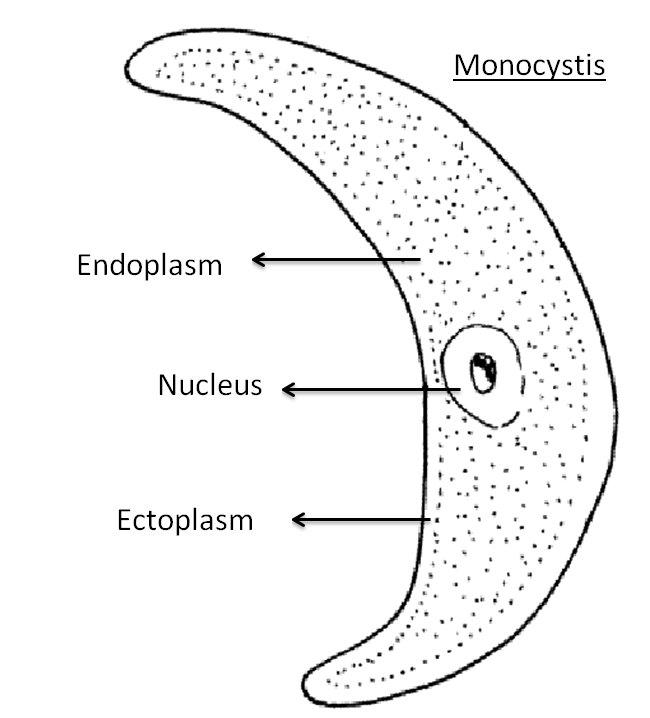
Monocystis belongs to the order of
(a)Gregarinida
(b)Coccidia
(c)Microsporidia
(d)Sarcosporidia
Answer
582.3k+ views
Hint: Monocystis is an internal parasite in the reproductive system of earthworms. Monocystis do not have protoplasm divided into segments by septa.
Complete answer:
Monocystis belong to Conoidasida- class, Gregarinasina- subclass, and Eugregarinorida order whereas sarcoporidia is an order of coccidian. Eugregarinorida order includes protozoa which are mainly parasitic to many invertebrates. They have large trophozoites that possess septate species or aseptate species. The presence of stiff cells on the surface for gliding movement forms epicyctic folds on their surface.

Additional Information:
-During the young stage, monocystis lives as an intracellular parasite in the bundle of developing sperms of earthworm where it lives and feeds the protoplasm of developing sperm makes the sperm dead surround by tails which is easily mistaken as ciliated organism.
-During the mature stage, monocystis is known as trophozoite and lives as an extracellular parasite in the seminal vesicles of the earthworm.
-The presence of monocystis in the earthworm is the common infection in mostly all mature earthworms.
-Monocystis doesn't have any locomotory organ thus shows wriggling and gliding movements.
-Monocystis stores its food material in the form of glycogen granules in the endoplasma.
-The outer thick and thick structure surrounding the body of trophozoite is called pellicle which is used as the mode of respiration by the process diffusion.
-Monocystis shows sexual reproduction.
So, the correct answer is, ‘Gregarinida.’
Note:
-Monocystis completes its life cycle in one host thus known as a monogenetic parasite.
-Monocystis found in the coelom and seminal vesicle of the earthworm.
-Monocystis contains four chromosomes in the nucleus.
-They show cylindroids, solitary and coelomic habitat in the earthworm.
Complete answer:
Monocystis belong to Conoidasida- class, Gregarinasina- subclass, and Eugregarinorida order whereas sarcoporidia is an order of coccidian. Eugregarinorida order includes protozoa which are mainly parasitic to many invertebrates. They have large trophozoites that possess septate species or aseptate species. The presence of stiff cells on the surface for gliding movement forms epicyctic folds on their surface.

Additional Information:
-During the young stage, monocystis lives as an intracellular parasite in the bundle of developing sperms of earthworm where it lives and feeds the protoplasm of developing sperm makes the sperm dead surround by tails which is easily mistaken as ciliated organism.
-During the mature stage, monocystis is known as trophozoite and lives as an extracellular parasite in the seminal vesicles of the earthworm.
-The presence of monocystis in the earthworm is the common infection in mostly all mature earthworms.
-Monocystis doesn't have any locomotory organ thus shows wriggling and gliding movements.
-Monocystis stores its food material in the form of glycogen granules in the endoplasma.
-The outer thick and thick structure surrounding the body of trophozoite is called pellicle which is used as the mode of respiration by the process diffusion.
-Monocystis shows sexual reproduction.
So, the correct answer is, ‘Gregarinida.’
Note:
-Monocystis completes its life cycle in one host thus known as a monogenetic parasite.
-Monocystis found in the coelom and seminal vesicle of the earthworm.
-Monocystis contains four chromosomes in the nucleus.
-They show cylindroids, solitary and coelomic habitat in the earthworm.
Recently Updated Pages
Why are manures considered better than fertilizers class 11 biology CBSE

Find the coordinates of the midpoint of the line segment class 11 maths CBSE

Distinguish between static friction limiting friction class 11 physics CBSE

The Chairman of the constituent Assembly was A Jawaharlal class 11 social science CBSE

The first National Commission on Labour NCL submitted class 11 social science CBSE

Number of all subshell of n + l 7 is A 4 B 5 C 6 D class 11 chemistry CBSE

Trending doubts
Differentiate between an exothermic and an endothermic class 11 chemistry CBSE

10 examples of friction in our daily life

One Metric ton is equal to kg A 10000 B 1000 C 100 class 11 physics CBSE

Difference Between Prokaryotic Cells and Eukaryotic Cells

State the laws of reflection of light

Explain zero factorial class 11 maths CBSE




